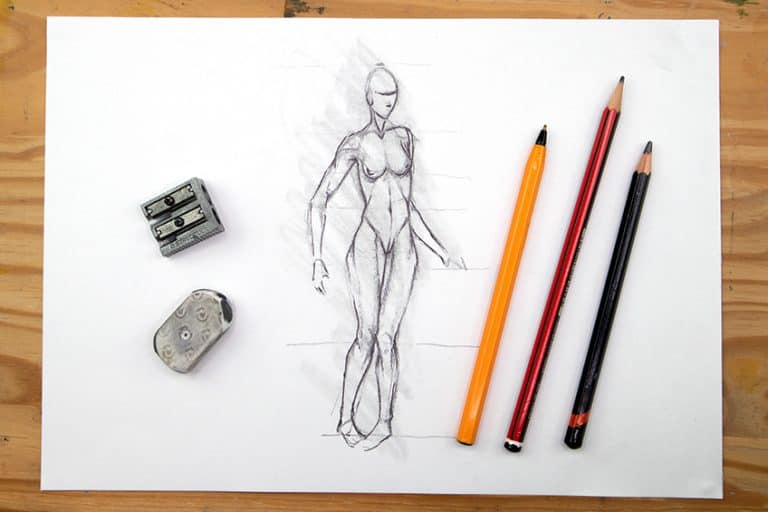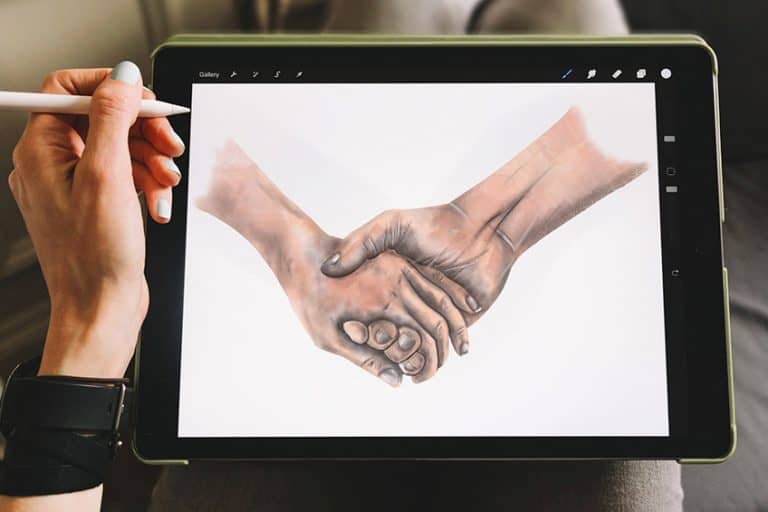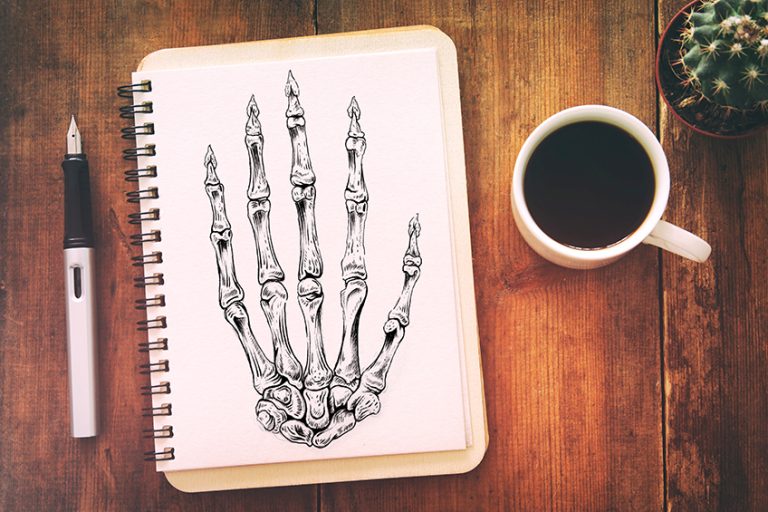How to Draw Hair – Learn How to Create an Easy Hair Drawing
Drawing hair or drawing hairstyles is less complicated than one thinks. The real challenge is in your patience and precision. However, the fundamental principle associated with drawing hair is quite simple. Drawing hair is simply a matter of strokes made with a pencil or pen. In this tutorial, we will be using both pen and pencil. This makes the process a little more challenging as we will have to have a lot of patience as we gently apply the strokes of the hair. When drawing hair, it is important to think about the nature of real hair, which is essentially a series of lines clumped together. This idea is what we want in the back of our heads as we go through this tutorial from start to finish.
Table of Contents
Necessary Materials
We will be using graphite pencils and pens. Pencils are helpful for hair drawing as they provide us with a template-like mark-making process which we will then apply pen over to bring our drawing to life. Using a pen as a drawing medium can mimic the realistic contrast qualities that we see in anatomical structures. We use the pen as a way to bring the drawing out and make it pop.
- A full set of pencils
- An eraser
- A sharpener
- A ballpoint pen
- Good paper
- Source material
Preparation and Source Image
For our hair drawing reference, we will be using an image of a female as her hair provides us with a unique challenge. The curls and brunette coloring of her hair have various tonal values that sit on the tonal spectrum between dark and light. With all our materials ready we can now begin our hair drawing process.
We have our pencils sharpened and our eraser, sharpener, and a full range of pencils ready for use. We should also have our source image next to us and our drawing station in a well-lit room. With all that being said it is time to draw.
Step-by-Step Guide on How to Draw Hair
In this tutorial, we will be doing a hair drawing. With hair drawing, we want to develop the skill of how to shade hair. There are various hairstyle drawings one can do when learning how to draw hair, in this tutorial we will be doing a female curly hairstyle drawing.
For our hair drawing reference, we will be using an image that we can either print or refer to directly from a smart device.
Drawing hairstyles is a great exercise for developing a general profile drawing skill. As we go through the various steps leading to the part of shading we will also learn how to develop the general skills of hair shading with a pen.
Step 1: Shaping the Hair Structure
Let us begin with shaping the hair structure. We do this by taking our H pencil and drawing a circle that defines the size of the head of the figure in your source image.

What we want to do is very loosely draw the shape of the hair outline whilst we use our source image as a guide for accuracy.


These segments, within the source image, are broken up by the shadows in the hair.
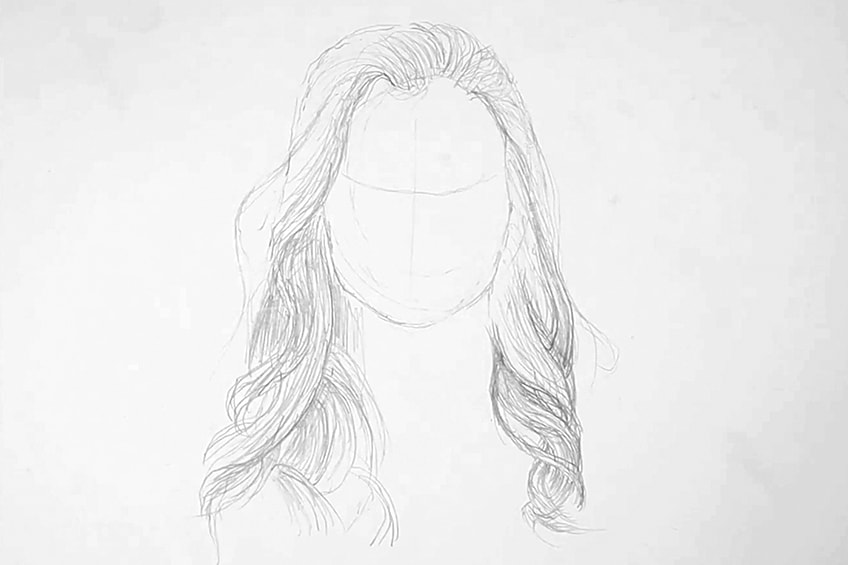
Hair shading is tricky and is an important part to grasp when learning how to draw realistic hair.
Step 2: Shading the Left Locks
Before we begin to draw and shade with a pen, take a moment to analyze your source image again. Consider the various shadows within the hair. We can see that shadowing is formed in little areas that seem to be inside of the hair as if you can see through the first layer of hair. Then there are moments when the hair is densely compact which prevents us from looking through the hair.
This will develop a sense of lightness or shine as the light has something to deflect off of. With your ballpoint pen, we will begin to shade the areas where we can see the shadow.

Again, try to notice the overlapping moments where the hair is clumped together and has a wave-like motion over another section that develops underneath it.

These are generally the darker moments.
As the hair comes out of each overlapping moment it becomes lighter again and slowly flows into another moment of the hair grouping. Keep in mind the action we are using with our pen is light strokes with moments of harder strokes as we come to the shadowy areas.

Taking a break gives us a fresh perspective which will help with the process.
This action of light strokes with a gentle hand is the aim of the shading process done with a pen. When learning how to draw realistic hair with a pen it is essential to understand the various pressures applied to the pen for various tones. Light hand for lighter tones and more pressure for darker strokes.
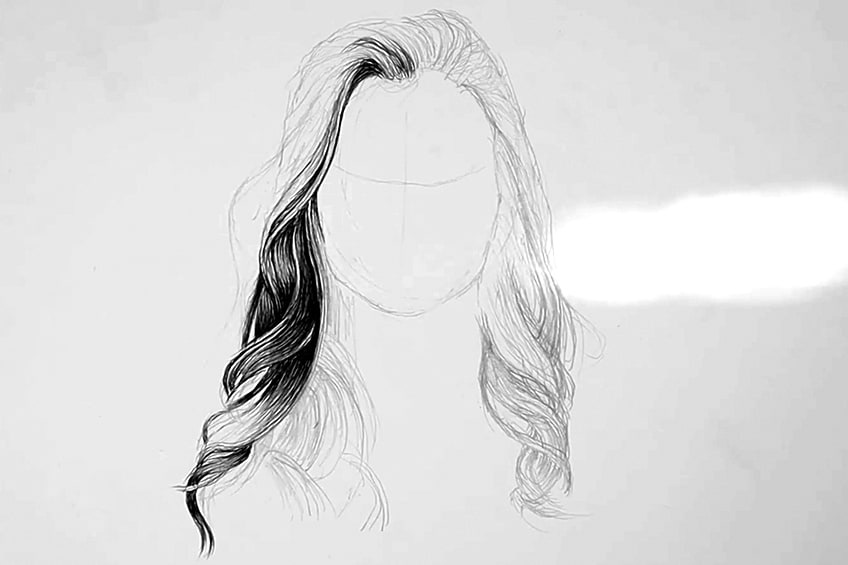
The action should be guided by the source image’s depiction of shadowing in the hair.

Drawing hairstyles require an emphasis on these little details.
Step 3: Shading the Right Locks
Let us shift our focus to the hair on the top of the head as we transition to the right side of the hair. We want to analyze the source image and see how the hairs sprout outwardly from the top of the head toward the left and right directions towards where the hair falls.
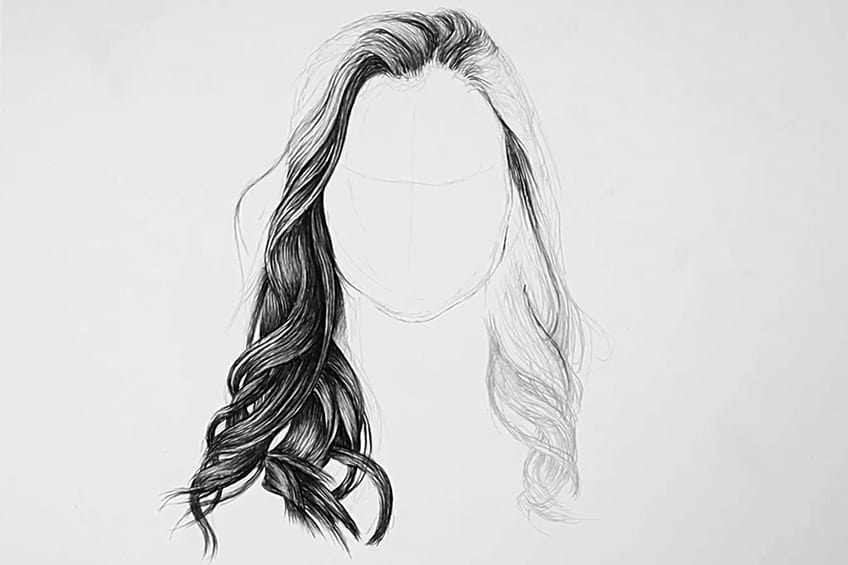
These details help us with learning how to draw hair more correctly.

We can keep doing this until we come to the moments of overlapping. Remember that the hair generally is exposed to light until it overlaps with other clumps of hair. These are the moments when our strokes become harder.
These areas create a lot of shadows.

Make sure you take note of this quality on the hair within the source image as you draw.

You should apply pressure near the areas of the hair where they overlap.
It is important to note that these overlapping moments create shadows which means we press harder to create that effect. However, we want to soften the pressure every time we draw the hairs coming out of a moment of overlapping. Think of it as softening the pressure to create a fading effect
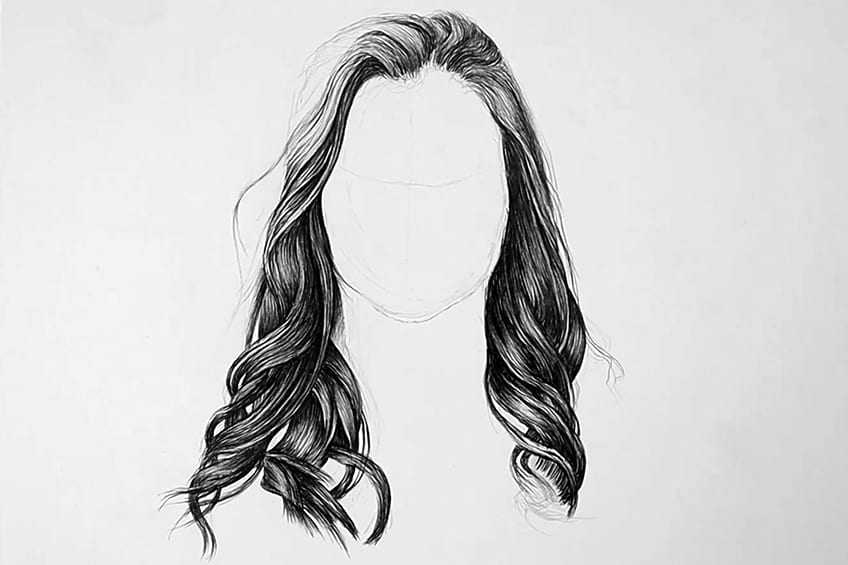
The duality of this gives the quality of how real hair sits naturally.

Step 4: Add On Effects
What we want to do now is go over our source image and take note of all the little wispy hairs around the head. These little rogue hairs can be drawn very lightly with our pens. This is a great way to give off the quality of how hair acts naturally.

This will create the effect of volume.


Do this from the middle part of the hair.

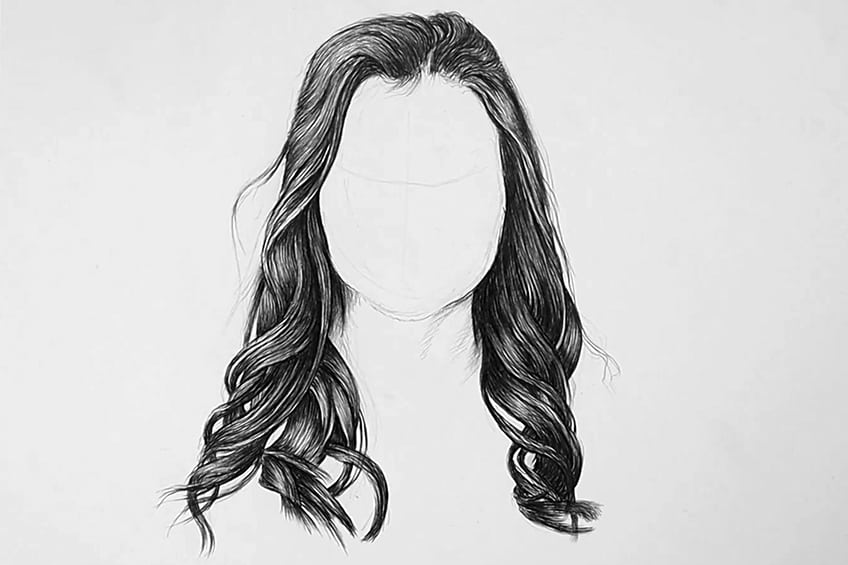
There you have it, how to draw hair in a few simple steps!
Tips to Remember
- Learning how to draw hair, especially learning how to draw realistic hair, requires attention to details and how they are defined in a reference image.
- This drawing is really about taking your time. If you find yourself feeling tired, don’t compromise your drawing, just take a break.
- When drawing hair with a pen, you always want to keep your strokes soft and light. And then slowly develop the darker moments of shading on top of the light lines.
- Try to fully develop the drawing with a pencil before you begin shading in with a pen where the hair should be light in the areas you want to attend to last. Generally, it is about working around the negative area with a pen to keep the effect of light.
- Always refer to your source image as you slowly work through the whole head of hair.
- Take time analyzing the source image for a better understanding of how to shade hair.
As we draw hair it is always important to keep in mind that the process is to mimic the actual quality of hair. When we think of hair, what it is is a series of lines compiled into groups that can be wavy, coily, straight, and so on. When these groupings merge or overlap, there is always a sense of shadowing that develops as an effect of that overlapping. This is where we slowly shade and add in darker tones. Another important aspect to remember is that in the light moments of the hair the lines are thick and thin. This creates the effect of depth. So, there are a few things that can make the hair look realistic but the fundamental principle is that we are drawing a series of lines moving in a particular direction.
Frequently Asked Questions
How to Draw Realistic Hair?
Learning how to draw realistic hair is about realizing what hair actually is. Hair is a series of fine lines that move in a particular direction. However, that motion can change which is what we see in curly hair. Depending on what kind of hair you want to draw, you want to observe that particular kind of hair in real life. What you will notice is that the real hair is a series of lines that are clumped together and when overlapping creates shadowing. The aim is to draw a series of lines in segments that can be divided by the moments of overlap in the hair. We draw the overlap by shading in these areas which are produced from a line that generally runs through a series of lines going in a single direction.
How Do I Draw Female Hair?
Learning how to draw hair or more specifically drawing female hair is a tricky task because all hair is different. However, when we draw straight hair, our lines have slight curves. When we draw wavy hair, such as in this tutorial, we draw hair that has a twisting motion. The point is that we need to analyze the source image of the hair we draw and then apply the principles of lines to the shape. The best idea is to do an outline of the hair and then slowly apply lines in the different hair segments or shapes in the hair. Then we shade the hair where there are overlapping moments or intertwined moments to give the hair a sense of volume.
How Do I Draw Wavy Hair?
Understanding different hair structures are essential to understanding the process of hair drawing. For wavy hair, the hairs generally have a twisting motion in them near the bottom and a bumpy motion near the top. Because the wavy hair of females can be heavy the top might seem slightly less bumpy. However, as the hair comes to the ends and tips they begin to move in various directions twisting in and around each other. The goal here is to get the outline of the shape correct and then slowly begin to add your lines and shades in the overlapping moments.
How to Shade Hair?
Learning how to shade hair for particular hairstyles drawing is tricky. It starts with understanding the overlaps of different types of hair. When we draw curly hair we approach hair shading by seeing how shadows are produced in curly hair in real life. The shadows are formed mostly by the moments where hair twists or overlaps. This is something to concentrate on with real hair to really grasp how the process of shading hair. As a rule of thumb, we should always try to develop the hair lines and then either shade over or in between them. This is the general guiding principle associated with learning how to shade hair.
Matthew Matthysen is an educated multidisciplinary artist and illustrator. He successfully completed his art degree at the University of Witwatersrand in South Africa, majoring in art history and contemporary drawing. The focus of his thesis was to explore the philosophical implications of the macro and micro-universe on the human experience. Matthew uses diverse media, such as written and hands-on components, to explore various approaches that are on the border between philosophy and science.
Matthew organized various exhibitions before and during his years as a student and is still passionate about doing so today. He currently works as a freelance artist and writer in various fields. He also has a permanent position at a renowned online gallery (ArtGazette) where he produces various works on commission. As a freelance artist, he creates several series and successfully sells them to galleries and collectors. He loves to use his work and skills in various fields of interest.
Matthew has been creating drawing and painting tutorials since the relaunch in 2020. Through his involvement with artincontext.org, he has been able to deepen his knowledge of various painting mediums. For example, watercolor techniques, calligraphy and lately digital drawing, which is becoming more and more popular.
Learn more about Matthew Matthysen and the Art in Context Team.
Cite this Article
Matthew, Matthysen, “How to Draw Hair – Learn How to Create an Easy Hair Drawing.” Art in Context. June 19, 2022. URL: https://artincontext.org/how-to-draw-hair/
Matthysen, M. (2022, 19 June). How to Draw Hair – Learn How to Create an Easy Hair Drawing. Art in Context. https://artincontext.org/how-to-draw-hair/
Matthysen, Matthew. “How to Draw Hair – Learn How to Create an Easy Hair Drawing.” Art in Context, June 19, 2022. https://artincontext.org/how-to-draw-hair/.






